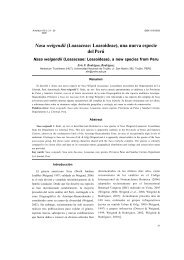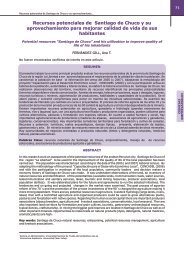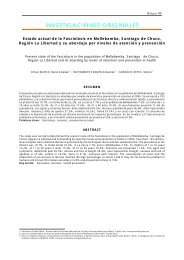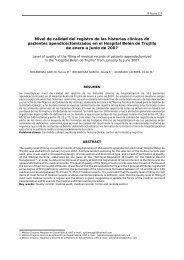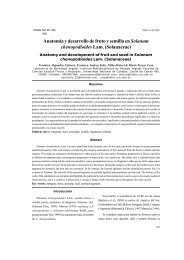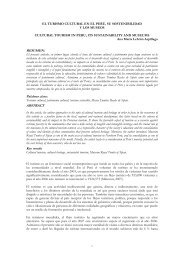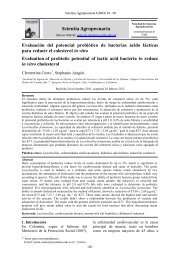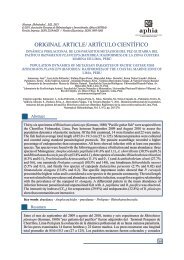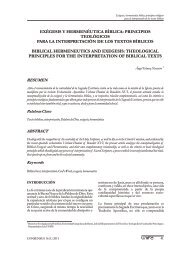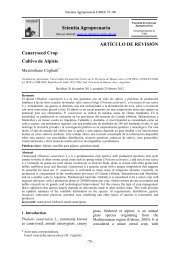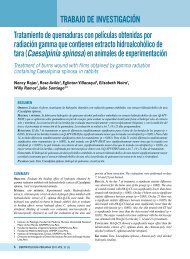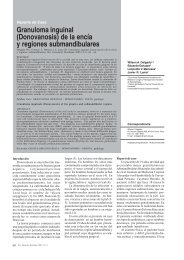52fueron la Tos (0.94), fiebre (0.8) y la rinorrea (0.86),con mejor especificidad la fotofobia (0.98), erupcióndérmica (0.98) y otalgia (0.95), con mejor VPP lacefalea (0.48), mialgias(0.43) fotofobia (0.33) y conmejor VPN la fiebre (0.88), cefalea (0.82) y mialgias(0.81). La dificultad respiratoria fue <strong>el</strong> criterio degravedad que se pres<strong>en</strong>tó con mayor frecu<strong>en</strong>cia,no habi<strong>en</strong>do difer<strong>en</strong>cias significativas <strong>en</strong>tre lospaci<strong>en</strong>tes con y sin la Influ<strong>en</strong>za A H1N1 (p>0.05).Conclusiones: El diagnóstico de Influ<strong>en</strong>zaAH1N1 puede ser sobreestimado cuando sebasa <strong>en</strong> signos y síntomas aislados lo que podríacondicionar un empleo exagerado de antivirales.S<strong>en</strong>sitivity and specificity of clinical signsand symptoms in influ<strong>en</strong>za H1N1 in aPediatric Hospital in Lima in the context ofa PandemicABSTRACT:Introduction: The influ<strong>en</strong>za A (H1N1) in 2009 is apandemic caused by a variant of swine influ<strong>en</strong>zaA (subtype H1N1). On April 30, 2009 the WorldHealth Organization (WHO) decided to call itinflu<strong>en</strong>za A (H1N1). The G<strong>en</strong>eral Directorate ofEpidemiology of the pandemic Perúal considereda fever associated with runny nose or cough orsore throat and previous contact as criteria forid<strong>en</strong>tifying suspected cases of Influ<strong>en</strong>za A (H1N1).Objective: To determine the s<strong>en</strong>sitivity andspecificity of signs and symptoms of H1N1influ<strong>en</strong>za in hospitalized pati<strong>en</strong>ts in the PediatricEmerg<strong>en</strong>cy Hospital Lima - Peru, in the context ofthe rec<strong>en</strong>t pandemic.Material and Methods: This comparativeobservational study, we evaluated the surveillancerecords of 340 hospitalized pati<strong>en</strong>ts, initiallyclassified as suspected H1N1 influ<strong>en</strong>za, whounderw<strong>en</strong>t nasopharyngeal confirmatory test forRT-PCR in real time.Results: 20.58% of suspected pati<strong>en</strong>ts wereconfirmed. No differ<strong>en</strong>ce in r<strong>el</strong>ation to g<strong>en</strong>der, agegroup with the biggest risk of getting sick was morethan 10 years of age (OR 2.11 CI: 1.15-3.88). Fever,headache and myalgia were more common in pati<strong>en</strong>tswith influ<strong>en</strong>za A H1N1 (p value
Temas <strong>libres</strong> <strong>pres<strong>en</strong>tados</strong> <strong>en</strong> <strong>el</strong> XXVI <strong>congreso</strong> peruana de pediatría - Iquitos 2010 53(33.85%), luego Shig<strong>el</strong>la flexnery (28.09%), Shig<strong>el</strong>lasonnei (11.07%), Campylobacter jejuni ( 6.27% ),E.C.E.P (5.49%), Shig<strong>el</strong>la boydii (3.93%), Shig<strong>el</strong>lasp. (3.48%) que repres<strong>en</strong>taron más d<strong>el</strong> 90% de losaislami<strong>en</strong>tos. Los m<strong>en</strong>ores de 1 año tuvieron mayorriesgo de <strong>en</strong>fermar con Campylobacter (OR:13.62I.C 11-16.8) y los de 1 a más años de edad tuvieronmayor riesgo de <strong>en</strong>fermar con Shig<strong>el</strong>la (OR: 15.92 IC:12.57-20.17). De los antibióticos y quimioterápicosevaluados los que pres<strong>en</strong>taron resist<strong>en</strong>cia m<strong>en</strong>or al5% para las difer<strong>en</strong>tes especies de Shig<strong>el</strong>la fueron:Acido Nalidixico, Nitrofurantoina y Furazolidona.Pres<strong>en</strong>taron resist<strong>en</strong>cia mayor al 60%: Amoxacilinaclavulanato,Cotrimoxasol y Cloranf<strong>en</strong>icol.Las especies de Campylobacter pres<strong>en</strong>taronresist<strong>en</strong>cia m<strong>en</strong>or a 5% a Eritromicina, Furazolidona,Cloranf<strong>en</strong>icol y Nitrofurantoina; Amoxicilina tuvouna resist<strong>en</strong>cia d<strong>el</strong> 29%, para Acido Nalidixico yCotrimoxasol la resist<strong>en</strong>cia fue mayor al 80%.Conclusiones: Las especies de Shig<strong>el</strong>la fueron lasbacterias más frecu<strong>en</strong>tem<strong>en</strong>te aisladas, seguidasde las especies de Campylobacter. Para <strong>el</strong> manejoambulatorio de infección por especies de Shig<strong>el</strong>la,se recomi<strong>en</strong>dan como medicam<strong>en</strong>tos empíricosde primera opción a los antibióticos que mostraronm<strong>en</strong>or resist<strong>en</strong>cia como Furazolidona, Acidonalidixico, Nitrofurantoina, debe evitarse <strong>el</strong> usode medicam<strong>en</strong>tos como Amoxicilina-clavulamato,Cotrimoxasol y Cloranf<strong>en</strong>icol.Si la infección es por especies de Campylobacterlos medicam<strong>en</strong>tos recom<strong>en</strong>dados son Eritromicina,Furazolidona, Cloranf<strong>en</strong>icol y Nitrofurantoina port<strong>en</strong>er la m<strong>en</strong>or resist<strong>en</strong>cia, se debe evitar <strong>el</strong> usode Cotrimoxasol y Acido Nalidixico.Etiology and Bacterial resistance in pati<strong>en</strong>tsacute diarrhea in outpati<strong>en</strong>t managem<strong>en</strong>t inPediatric Emerg<strong>en</strong>cy Hospital Lima Peru2005-2009ABSTRACT:Introduction: Acute diarrheal disease remainsa common cause of visits in pediatric pati<strong>en</strong>ts.Bacterial isolation and id<strong>en</strong>tification of antibioticresistance are important for their rational use.Materials and methods: We conducted aretrospective observational study in childr<strong>en</strong> under19 who were treated as outpati<strong>en</strong>ts in the PediatricEmerg<strong>en</strong>cy Hospital with a diagnosis of acute diarrhealdisease betwe<strong>en</strong> 2005 and 2009, who underw<strong>en</strong>tstool culture. In the positive stool ag<strong>en</strong>t was id<strong>en</strong>tifiedand determined resistance to antibiotics.Results: Of the 3989 childr<strong>en</strong> with acute diarrheawere admitted to study for analysis a total of2186 (54.80%) who tested positive for a germ<strong>en</strong>teropathog<strong>en</strong>ic. All childr<strong>en</strong> under 5 yearsaccounted for 85.91%, with an average of 1.02years, 53.89% were male. The <strong>en</strong>teropathog<strong>en</strong>icthat was most frequ<strong>en</strong>tly isolated Campylobacter sp(33.85%), th<strong>en</strong> flexnery cultures Shig<strong>el</strong>la (28.09%),Shig<strong>el</strong>la sonnei (11.07%), Campylobacter jejuni(6.27%), EPEC (5.49%), Shig<strong>el</strong>la boydii (3.93%),Shig<strong>el</strong>la spp. (3.48%) repres<strong>en</strong>ting over 90%of the isolates. All childr<strong>en</strong> under 1 year had ahigher risk of becoming ill with Campylobacter(OR: 13.62 CI 11-16.8) and the 1 or more years ofage had a higher risk of becoming ill with Shig<strong>el</strong>la(OR: 15.92 CI: 12.57-20.17). Of antibiotics andchemotherapeutic ag<strong>en</strong>ts evaluated were resistantto less than 5% for differ<strong>en</strong>t species of Shig<strong>el</strong>lawere: nalidixic acid, nitrofurantoin and furazolidone.Showed resistance greater than 60%: amoxicillinclavulanate,cotrimoxazole and chloramph<strong>en</strong>icol.Campylobacter species showed less than5% resistance to erythromycin, furazolidone,chloramph<strong>en</strong>icol and nitrofurantoin, amoxicillin hada 29% resistance to nalidixic acid and cotrimoxazoleresistance was greater than 80%.Conclusions: Shig<strong>el</strong>la species were themost common bacteria isolated, followed byCampylobacter species. For the ambulatorymanagem<strong>en</strong>t of species of Shig<strong>el</strong>la infection,drugs are recomm<strong>en</strong>ded as first choice empiricalantibiotics showed less resistance as furazolidone,nalidixic acid, nitrofurantoin, avoid the use of drugssuch as amoxicillin-clavulamato, cotrimoxazoleand chloramph<strong>en</strong>icol.If the infection is Campylobacter species are therecomm<strong>en</strong>ded drugs erythromycin, furazolidone,chloramph<strong>en</strong>icol and nitrofurantoin for having th<strong>el</strong>east resistance, avoid the use of cotrimoxazoleand nalidixic acid.Objectives: To describe the bacterial pathog<strong>en</strong>scausing acute diarrheal disease and resistance toantibiotics and chemotherapy in childr<strong>en</strong> treated atthe Pediatric Emerg<strong>en</strong>cy Hospital in Lima, Peru.



